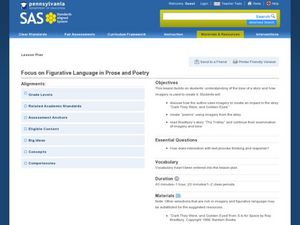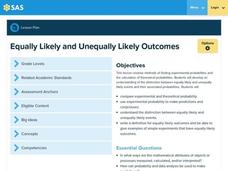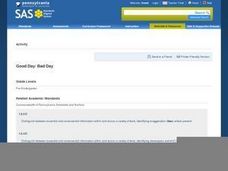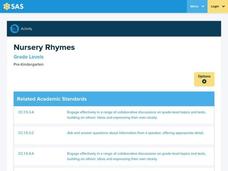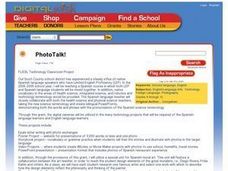Curated OER
The History of Computers
Students study the people and inventions related to computers. They research famous people for each invention they created and create a timeline of the inventor and his inventions. They present an oral presentation about the person for...
Curated OER
Main Events in Fiction
Students complete a literature analysis of fiction texts to study elements of fiction. In this fiction analysis lesson, students read various fiction texts and examine them to learn about fiction elements. Students learn to draw...
Pennsylvania Department of Education
Adding and Subtracting Three-Digit Numbers by Jumping
Second graders use data to graph information and draw conclusions. In this lesson on data analysis, 2nd graders practice gathering, sorting, comparing, and graphing data. Students differentiate data that can and cannot change over time.
Curated OER
Review of Personification and Alliteration
Students study personification and alliteration in various fiction texts. In this literary devices lesson, students use various texts to identify the literary devices of personification and alliteration. Students use examples of both...
Curated OER
Focus on Figurative Language in Prose and Poetry
Students place emphasis on the use of figurative language when analyzing prose and poetry. In this figurative language instructional activity, students explore the tone of a story and its imagery. Students read and discuss how the author...
Pennsylvania Department of Education
Equally Likely and Unequally Likely Outcomes
Students explore probability. In this statistics/probability instructional activity, students compare experimental and theoretical probability and use experimental probability to make predictions and conjectures. Students explore the...
Curated OER
Circle Graphs
Sixth graders interpret, create, and display data in a circle graph. In this circle graph lesson plan, 6th graders use a compass, protractors, pizza boxes, and more to create a circle graph and analyze the data they put into it.
Curated OER
Match word and picture
For this letter r worksheet, students match the words to the pictures that begin with the letter r. Students match 6 words to 6 pictures.
Curated OER
What Are The Chances
Students calculate the probability of an event occurring. In this probability lesson, students differentiate between independent, dependent or compound events. They find the range of the data.
Curated OER
Area of Triangle Worksheet
In this area worksheet, students find the area of a triangle given the height and the base. They also find the height or base given the area of the triangle.
Curated OER
Could You Do Me a Favour?
Students role play situations where they make requests to each other. In this requests lesson plan, students make their requests in English.
Pennsylvania Department of Education
Listen Well
Students read the book Koala Lou and then retell the story to demonstrate how well they were listening. For this listening lesson plan, students can also listen to the story on tape.
Pennsylvania Department of Education
The Talking Feather
Students use the feather when they want to talk and the rest of the class listens. In this listening lesson plan, students practice good manners by respecting the student with the feather.
Pennsylvania Department of Education
Comparing Two Versions of The Mitten
Students listen to two versions of the story The Mitten and create a chart or a Venn Diagram to compare the two versions. In this literary comparison lesson plan, students create a chart or Venn Diagram and discuss the differences in...
Curated OER
Wild Thing!
Students read Where the Wild Things Are. In this language arts lesson, students read the story and retell the story. Students tell a version of the story in which they turn themselves into wild things.
Curated OER
Flavorful Friends
Students read a book about friends, talk about good friends, and make "flavorful friends" out of food. In this friends lesson plan, students make their "friends" out of cookies, raisins, m&m's, and more.
Curated OER
Good Day/Bad Day
Students read the book Alexander and the Terrible, Horrible, No Good, Very Bad Day and discuss a bad day that they have had. In this bad day lesson plan, students compare their bad day with the story.
Curated OER
Pre-k Book Talk
Pupils read the book Corduroy and tell if they liked or didn't like the story. For this books lesson plan, students have a stuffed bear to hold while reading the story.
Pennsylvania Department of Education
Nursery Rhymes
Students retell a memorized nursery rhyme. In this early public speaking activity, students retell a familiar nursery rhyme with the help of visual prompts.
Pennsylvania Department of Education
Analyzing Key Ideas and Details in Nonfiction
Students explore nonfiction texts. For this language arts lesson, students read a nonfiction text and make predictions. Students identify facts and opinions in the text and draw conclusions as they read.
Curated OER
Making Predictions by Analyzing Key Ideas and Details
Young scholars make predictions. In this language arts lesson plan, students read nonfiction texts and make predictions about what they are going to read. Young scholars confirm and revise their predictions as they read the text.
Curated OER
To Be or Not To Be - Main/Helping Verbs
Fourth graders focus on the use of main and helping verbs in written communication.
Pennsylvania Department of Education
Stories? Information? What's the Difference?
Students listen to a power point presentation to distinguish between fiction and nonfiction text. In this what's the difference lesson, students identify fact from opinion within a text. Students listen critically and respond to text.
Curated OER
Photo Talk!
Students communicate with Epals. They write letters with photo exchanges
and create a website for presentations of 3,000 words or less and one photo. They
tell their life stories and illustrate with photos in the target language.
V
Other popular searches
- I Robot the Movie
- Esl Lessons I, Robot
- I Robot Worksheets
- Esl Lessons I Robot
- I Robot Literature
- I Robot Listening Activities
- Lessons I Robot
- Lessons I, Robot
- I, Robot Worksheets
- I Robot Issac Asimov
- I Robot Globalisation
- I Robot Globalization






